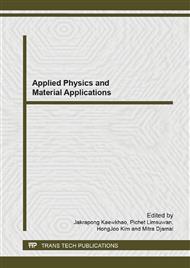p.112
p.116
p.120
p.124
p.128
p.132
p.136
p.140
p.145
Increasing the Melting Ability of Glass Batch by Batch Modification
Abstract:
The soda-lime glass with the composition of 74SiO2-18Na2O-6CaO-B2O3-Al2O3 thermodynamically requires the exploited heat of 557 kW/ ton of glass to transform raw materials into glass. The objective of this project is to modify the soda-lime glass batch by using wollastonite instead of limestone and pyrophyllite instead of aluminium hydroxide. The exploited heat of the batch with wollastonite is reduced to 546 kW/ton of glass while the batch with wollastonite and pyrophyllite is decreased to 550 kW/ton of glass. According to Batch-Free Time testing, it is found that the melting ability of both modified batches is higher than of the original batch, while the properties of glass are slightly changed. This implies that the modified batch requires a lower melting energy than the original batch.
Info:
Periodical:
Pages:
128-131
Citation:
Online since:
September 2013
Keywords:
Price:
Сopyright:
© 2013 Trans Tech Publications Ltd. All Rights Reserved
Share:
Citation:


